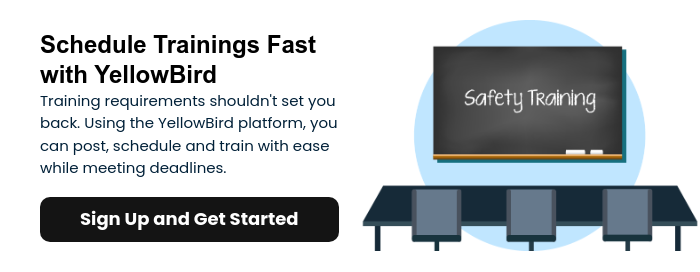What Will You Gain From an OSHA 30 Training?

What Will You Gain From an OSHA 30 Training?
An OSHA 30-hour training verifies that an individual has received education on workplace health and safety standards. In 1970, OSHA — or the Occupational Health and Safety Administration — was established to protect individuals from unsafe work conditions. To achieve this, OSHA created a set of compliance standards that address a variety of safety hazards in the workplace.
OSHA currently provides ongoing outreach training to ensure workers remain educated on federal laws regarding safe work practices. OSHA training also outlines employer responsibilities for providing a workplace free of health or safety violations. Workers across a range of industries are required by law to undergo OSHA training — and refresher courses must be completed every 12 months.
What Is the OSHA 30-Hour Training Course?
The OSHA 30-hour training states that an individual has undergone and completed 30 hours of in-depth work-site education and supplied them with the knowledge needed to mitigate health and safety hazards in the workplace.
The purpose of OSHA 30-hour training is to inform workers and supervisors across many industries about the basics of workplace safety, covering topics such as ergonomics, emergency egress planning, PPE protocols, and fall protection. The 30-hour general industry course expands upon work hazards like blood-borne pathogens, asbestos awareness, hazardous material handling, and electrical safety.
How Does OSHA 30-Hour Training Work?
Below is a quick look at two variants of the OSHA 30-hour training. Participants of all OSHA 30 classes must pass a 10 question quiz at the end of each module to proceed to the next section. At the end of the training course, participants must take a 20 question exam covering information from all modules.
Those who answer at least 70% of the questions correctly on the final exam receive a passing grade. Participants have six months to complete the training. If the coursework remains unfinished after that time frame, OSHA 30 course participants will need to retest.
What Will You Gain From OSHA Training?
OSHA 30 training gives workers considerable knowledge of the best practices for recognizing, navigating, and preventing many different hazards. Individuals can gain valuable insights from OSHA training to protect themselves and their coworkers on the job.
By providing OSHA training to employees, owners or managers can ensure compliance standards are collectively understood and each worker is aware of their contribution to safety. Businesses that invest in OSHA training courses for their staff demonstrate a commitment to workplace safety that sets a positive example for others to follow.
30-Hour General Industry Overview
The OSHA 30-hour course for general industry is separated into 23 modules that go over many common workplace hazards shared among numerous industries. After a brief orientation and introduction, the trainer guides participants through safety data sheets (SDS) and how labels are used to classify specific hazards.
Key aspects of the general industry course examine lockout and tag-out procedures, fall protection, and regulations for hazardous waste operations. Additional topics of interest reviewed in training include safe management of hazardous materials such as compressed gas or flammable liquids.
30-Hour Construction Overview
This OSHA 30 course consists of 21 modules covering hazards specific to the construction industry. Participants will learn about common environmental hazards in construction, including substances like silica and lead.
Other important sections of training offer guidance for responsible use of power tools along with welding and cutting safety. The 30-hour OSHA construction program outlines requirements for using barricades and signage to cordon off safety hazards. Some important materials also explored include ladder safety, the danger of confined spaces, and proper use of equipment such as cranes or conveyors.
What Are the Main Takeaways From the OSHA30 Course?
OSHA’s 30-hour training course gives workers the knowledge they need to identify and effectively prevent potential hazards in the workplace.
By educating workers on OSHA’s safety standards, businesses can drastically reduce the occurrence of accidents or injuries on the job. Those who have completed the 30-hour training will be more prepared to respond correctly to various health and safety hazards in the workplace. Here are some main takeaways from the program:
- 30-hour training programs are customized and tailored to address the most relevant topics for the audience and their industry
- Companies can foster a more safety-conscious work culture by providing their workers with 30-hour OSHA training
- Outreach training is available in several languages to accommodate workers from all backgrounds
- The subject matter of OSHA outreach training delves into content such as worker’s rights and how-to-file workplace safety complaints
- Training encourages group participation with engaging hands-on activities
- Training highlights the importance of protecting the safety of all workers, including those who are young or less experienced
- Workers are informed about employer responsibilities for providing a safe work environment
How Can You Avoid Fraudulent Courses and Obtain Your OSHA Card?
Various fraudulent advertisements offering OSHA 30-hour training continue to circulate. Individuals who come in contact with a fraudulent training provider should notify the Office of the Inspector General. Compliance officers, safety managers, or business owners can avoid fraudulent courses by only scheduling classes with OSHA-authorized training providers.
Trainers approved by OSHA should possess a valid trainer card. This card should indicate where the card was issued and when it is set to expire. OSHA also provides a public list of trainers who are authorized to teach an OSHA 30 class. Individuals are advised to be wary of trainers who offer any guarantees of employment for completing the coursework.
It’s also important to note that only authorized trainers can distribute OSHA cards at the end of training. In many cases, temporary certificates of completion are distributed after class while permanent OSHA cards are sent through the mail, often arriving within two weeks or less.


